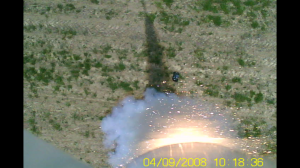Flight reports…Nesaru flights NLS-004 and NLS-005
(Cuyahoga Falls, OH)
Well…I’m a bit late on one report, and on time for another.
NLS-004 recap
On Sunday, May 5, 2013 Nesaru mission NLS-004 was held in Amherst, OH at the GLRMR 2013 meet. Winds were quite brisk, averaging around 17 MPH, with a few gusts about 10 MPH higher from time to time. Definitely a day to test the aerodynamic characteristics to the max limits of the rules, for sure!
Based on flight data on the Perseus boosters (a design that Nesaru is based very closely on), I was expecting to see very favorable results. The flight went without a hitch, and Nesaru plowed a straight line into the heavens even through the various layers of higher velocity wind shear forces on the way up.
The problem on that mission was this: Human Error. I did not tighten the screw switch down enough during launch preparation. This switch powers the flight computer systems on board Nesaru. The vibrations of launch caused the screw to back out enough to not give reliable power when the rocket reached apogee. Nesaru fell about 150 feet, at which point the backup (time delay) charges activated, deploying the parachute, guiding the rocket to a safe landing.
No one (except me) realized that things didn’t go as planned. Just the way you want it to be. The crowd at the spectator line cheered and clapped over the spectacular flight. Whew!
There were no pictures as I wanted to just watch this flight. Motor: CTI H135, apogee: 1550 feet.
NLS-005 was two weeks later, same location. (May 18, 2013). This flight was the opposite of NLS-004. Not only did things go well, it was also the most photographed launch of any of my rocket launches. My brother was there to take still pictures as well as the usual videos of launch both from the ground and from on-board Nesaru.
The flight was totally text book. Or should I use the favorite word from the commercial rocket programs these days… The mission was “nominal”. 🙂
Nesaru once again flew on a CTI H135 motor, reaching a top speed of about 348 MPH, and a peak altitude of 1440 feet.
Analysis of all data as well as flight videos shows absolutely no anomalies during flight. Besides the human error element of two flights, and the poor alkaline battery performance on the first flight, the performance of the rocket itself on all 5 flights have been absolutely superb.
The next flight for Nesaru is scheduled for sometime in October 2013. There is a chance I may get to fly her at some point at an out of town (or out of state) launch site at some point, but for now, the official next launch date is October 2013.
The post-flight clean up duty has begun on Nesaru, and it will continue for the next few days.
More later!
((( )))




